A member of three Brazilian World Cup-champion teams, Pelé is considered by many to be the greatest soccer player of all time.

(1940-2022)

Who Was Pelé?
Soccer legend Pelé became a superstar with his performance in the 1958 World Cup. Pelé played professionally in Brazil for two decades, winning three World Cups along the way, before joining the New York Cosmos late in his career. Named FIFA co-Player of the Century in 1999, he was a global ambassador for soccer and other humanitarian causes.
Pelé was born Edson Arantes do Nascimento on October 23, 1940 in Três Corações, Brazil, the first child of João Ramos and Dona Celeste. Named after Thomas Edison and nicknamed "Dico," Pelé moved with his family to the city of Bauru as a young boy.
João Ramos, better known as "Dondinho," struggled to earn a living as a soccer player, and Pelé grew up in poverty. Still, he developed a rudimentary talent for soccer by kicking a rolled-up sock stuffed with rags around the streets of Bauru. The origin of the "Pelé" nickname is unclear, though he recalled despising it when his friends first referred to him that way.
As an adolescent, Pelé joined a youth squad coached by Waldemar de Brito, a former member of the Brazilian national soccer team. De Brito eventually convinced Pelé's family to let the budding phenom leave home and try out for the Santos professional soccer club when he was 15.
Soccer's National Treasure
Pelé signed with Santos and immediately started practicing with the team's regulars. He scored the first professional goal of his career before he turned 16, led the league in goals in his first full season and was recruited to play for the Brazilian national team.
The world was officially introduced to Pelé in the 1958 World Cup in Sweden. Displaying remarkable speed, athleticism and field vision, the 17-year-old erupted to score three goals in a 5-2 semifinal win over France, then netted two more in the finals, a 5-2 win over the host country.
The young superstar received hefty offers to play for European clubs, and Brazilian President Jânio Quadros eventually had Pelé declared a national treasure, making it legally difficult for him to play in another country. Regardless, Santos club ownership ensured its star attraction was well paid by scheduling lucrative exhibition matches with teams around the world.
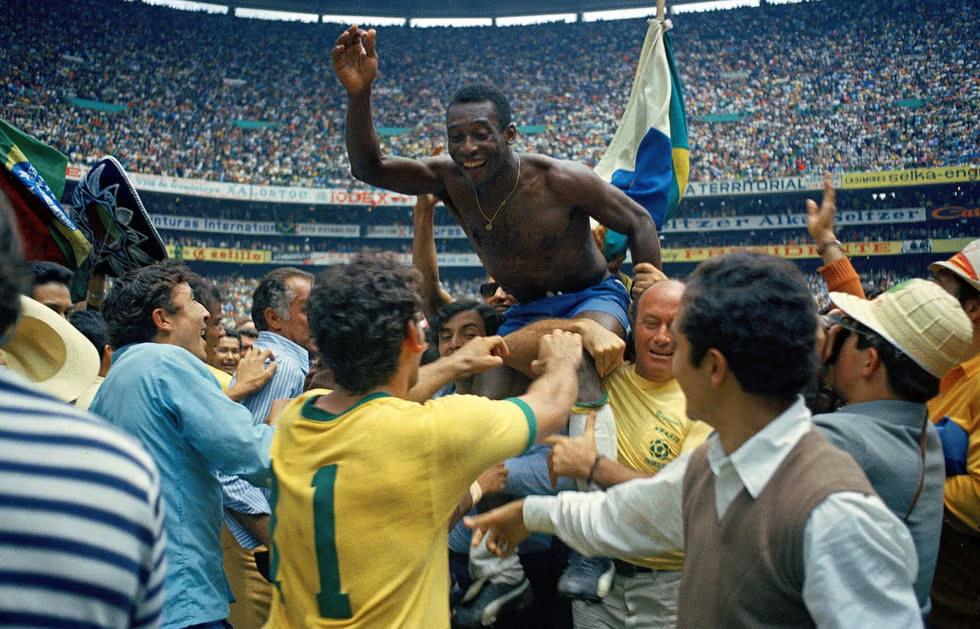
More World Cup Titles
Pelé aggravated a groin injury two games into the 1962 World Cup in Chile, sitting out the final rounds while Brazil went on to claim its second straight title. Four years later, in England, a series of brutal attacks by opposing defenders again forced him to the sidelines with leg injuries, and Brazil was bounced from the World Cup after one round.
Despite the disappointment on the world stage, the legend of Pelé continued to grow. In the late 1960s, the two factions in the Nigerian Civil War reportedly agreed to a 48-hour ceasefire so they could watch Pelé play in an exhibition game in Lagos.
The 1970 World Cup in Mexico marked a triumphant return to glory for Pelé and Brazil. Headlining a formidable squad, Pelé scored four goals in the tournament, including one in the final to give Brazil a 4-1 victory over Italy.
Pelé announced his retirement from soccer in 1974, but he was lured back to the field the following year to play for the New York Cosmos in the North American Soccer League, and temporarily helped make the NASL a big attraction. He played his final game in an exhibition between New York and Santos in October 1977, competing for both sides, and retired with a total of 1,281 goals in 1,363 games.
Later Years, Death and Legacy
Retirement did little to diminish the public profile of Pelé, who remained a popular pitchman and active in many professional arenas.
In 1978, Pelé was awarded the International Peace Award for his work with UNICEF. He also served as Brazil's Extraordinary Minister for Sport and a United Nations ambassador for ecology and the environment.
Pelé was named FIFA's "Co-Player of the Century" in 1999, along with Argentine Diego Maradona. To many, his accomplishments on the soccer field will never be equaled, and virtually all great athletes in the sport are measured against the Brazilian who once made the world stop to watch his transcendent play.
Pelé died on December 29, 2022 in São Paulo, Brazil. He was 82 years old.
QUICK FACTS
- Birth Year: 1940
- Birth date: October 23, 1940
- Birth City: Três Corações
- Birth Country: Brazil
- Gender: Male
- Best Known For: A member of three Brazilian World Cup-champion teams, Pelé is considered by many to be the greatest soccer player of all time.
- Astrological Sign: Scorpio
- Nacionalities
- Death Year: 2022
- Death date: December 29, 2022
- Death City: São Paulo
- Death Country: Brazil
We strive for accuracy and fairness.If you see something that doesn't look right, contact us !
CITATION INFORMATION
- Article Title: Pelé Biography
- Author: Biography.com Editors
- Website Name: The Biography.com website
- Url: https://www.biography.com/athlete/pele
- Access Date:
- Publisher: A&E Television Networks
- Last Updated: December 29, 2022
- Original Published Date: April 2, 2014
- I was born to play football, just like Beethoven was born to write music and Michelangelo was born to paint.
Black History
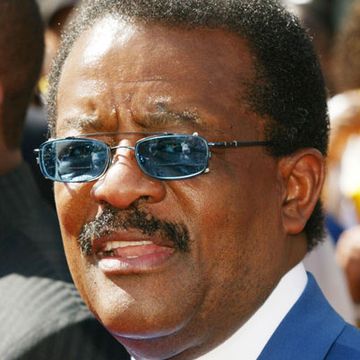
Jesse Owens

Alice Coachman

Wilma Rudolph

Tiger Woods

Deb Haaland

10 Famous Langston Hughes Poems

5 Crowning Achievements of Maya Angelou

Ava DuVernay

Octavia Spencer

Inventor Garrett Morgan’s Lifesaving 1916 Rescue

Get to Know 5 History-Making Black Country Singers
- Tournaments
Home › Players › Pelé
B orn on October, 23, 1940 in Minas Gerais, Brazil, Edson Arantes do Nascimento would become more commonly known around the world as Pelé. His father, João Ramos do Nascimento, played professional soccer himself, but his career never brought him much in the way of money. As the legend goes, Pelé’s family could not even afford to buy a ball for him, so he stuffed socks and molded them into the shape of a ball to kick around.
Basic facts
Birth: 1940 Death: 2022 Country: Brazil Position: Forward
Santos FC (1956-1974) New York Cosmos (1975-1977)
Club football: 694 matches, 650 goals National team: 92 matches, 77 goals
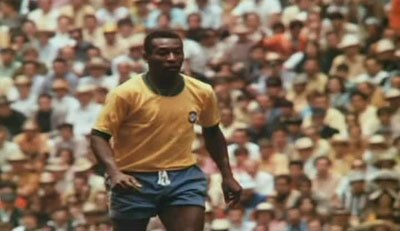
Early career
Although he continued to struggle financially in São Paulo, working a variety of jobs to help his family, the young Pelé found his true talent on the field. Under the tutelage of his father and a former national team player named Waldemar de Brito, Pelé began to mature as a player on the Bauru Athletic Club juniors. Coach de Brito recognized his ability and recommended him for a tryout with Santos FC. The team’s management agreed with de Brito’s assessment and signed Pelé in June 1956. A mere three months later, Pelé scored a goal in his debut match. Although few people knew it at the time, this foreshadowed the success to come in the rest of Pelé’s professional career.
Stardom of a youngster
Only a short year later, Pelé topped the list of scorers in the league. His performance, at the tender age of 17, caught the attention of the national team. He would not disappoint. In his first appearance on the world stage, he scored key goals in both the semifinal and the final match of the 1958 World Cup to win it for Brazil . At this point, he had achieved superhero status in Brazil and became a household name around the world. The Brazilian government honored him as a “national treasure,” which elevated his status at home, but also prevented him from taking advantage of offers a broad.
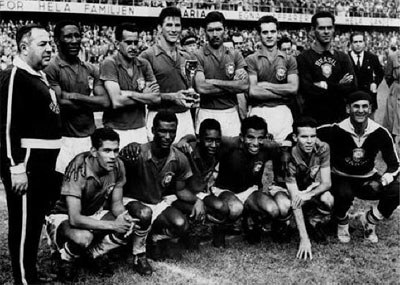
Struggle with injuries
On an individual level, the next two World Cups turned out disappointing due to injuries. The Brazilian side still won the tournament in 1962, but they fell way short in 1966 without their star player—they were eliminated in the group stage. During this era, though, Pelé continued to excel on his club team, Santos. Consistently a top scorer, he often faced teams who had altered their play specifically to deal with the threat he posed. Despite this, he still managed to score 60 goals in the 1964 season and 101 goals the year after that.
Retirement and comeback
By the time 1970 rolled around, Pelé had reportedly decided to hang up his hat and leave while he was on top. However, he was eventually coaxed into playing one last World Cup for Brazil in Mexico on what many consider as the best team in history. Pelé contributed to Brazil’s tournament win with goals and several important assists, earning himself the Golden Ball award for his play. Pelé continued with the Brazilian team for about another year, finally calling it quits in 1971. A few years after that, he said goodbye to his fans at Santos, too. His days as a player were still not over, though.
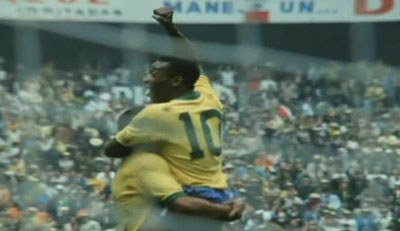
Late career
Although he had long said that he would only ever play for Santos, he could not resist answering the call from the New York Cosmos in 1975. The North American Soccer League (NASL) represented a significant step down in terms of the level of play that Pelé was accustomed to. The burgeoning league benefitted greatly from this ambassador of the game, though, and ticket sales rose. The American public, largely unfamiliar with the game, took notice. Pelé led the Cosmos to a championship before retiring for good, an event marked by an exhibition match between his adoptive New York team and Santos.
Legacy and life after the football career
At the time of his retirement in 1977, Pelé had amassed a series of seemingly unbreakable records. He had racked up a total of 1,283 goals in 1,363 matches, making him the top scorer in Brazilian national team history and FIFA history. Just as impressively, he managed to pull off 92 hat-tricks. He also set a record for the most FIFA World Cup wins for an individual, with three medals to his name. His early years should not be overlooked, though. The young Pelé burned bright, becoming the youngest player to score a hat-trick and the youngest player to score in a World Cup final match. Retirement saw “O Rei” go on to campaign for a variety of causes, including poverty reduction, anti-corruption movements, and environmental protection. He also received an honorary knighthood, served as the Minister of Sport in Brazil, and assumed the role of a UNICEF Goodwill ambassador. Of course, he never stopped promoting the game throughout the world, including FIFA events and Olympic ceremonies. Perhaps most memorable of all, he popularized the phrase “the beautiful game” as shorthand for the game he loved so much. Generations of enthusiasts have imagined themselves playing with the grace and beauty of “The Black Pearl.” He could strike the ball with astonishing accuracy or flick it off to a teammate through a thick web of defenders’ legs. His iconic goal-scoring bicycle kick in Belgium in 1968 sent young players from all over rushing outside for hours of painful practice. What dazzled many of his fellow players was his uncanny ability to work his way out of almost any situation with sheer skill. For those who have wondered about the origin of the name “Pelé,” the answer proves elusive. Some have claimed that it came from Pelé’s poor pronunciation of the name of a goalie he admired named “Bilé.” According to this version of events, his teammates half-mockingly gave him the name “Pelé” and he could not shake it. Pelé himself has never given a definitive account of how he got the name. In fact, he claimed he never cared for it much. Like so much else in this superstar’s life, though, the magic lies not in minute biographical details or trivia, but in the legacy that Pelé left on the field. Pelé passed away in december 2022, at the age of 82.
By Rosa Nelson
More articles
› Rivellino – King of the Park › Lev Yashin – The Black Spider › Alfredo Di Stéfano – The Blond Arrow
References: http://www.biography.com/people/pel%C3%A9-39221#more-world-cup-titles http://www.telegraph.co.uk/sport/football/world-cup/10874465/How-and-why-Peles-mystique-and-reputation-as-the-worlds-greatest-ever-footballer-has-been-overhyped.html http://www.goal.com/en/news/60/south-america/2010/10/21/2176031/70-facts-about-brazil-legend-pele Image source: Image sources: 1, 3 FIFA – World Cup Official Film 1970 2 Scanpix
Football Players
- Marco van Basten
- Franz Beckenbauer
- David Beckham
- Dennis Bergkamp
- George Best
- Zbigniew Boniek
- Bobby Charlton
- Johan Cruyff
- Alfredo Di Stéfano
- Steven Gerrard
- Gheorghe Hagi
- Ruud Gullit
- Thierry Henry
- Michael Laudrup
- Diego Maradona
- Gerd Müller
- Michel Platini
- Juan Román Riquelme
- Arjen Robben
- Hugo Sánchez
- Hristo Stoichkov
- Hakan Şükür
- George Weah
- Zinedine Zidane
- Gianfranco Zola
Biography Online

Pele Biography
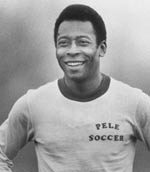
“I was born for soccer, just as Beethoven was born for music.” – Pele
Pele was born Edson Arantes do Nascimento on 23 October 1940 in Três Corações, Minas Gerais, Brazil. He was named after the American inventor Thomas Edison (his parents removed the i). In his childhood, he gained a nickname ‘Pele’ – after he mispronounced the name of a goalkeeper ‘Bile’ – Initially Pele disliked it and complained, but the more he complained, the more it stuck. Pele has no meaning and was intended as an insult, though later it was found that the word Bilé is Hebrew for “miracle.”
Pele grew up in poverty in São Paulo. He was taught to play football by his father (who used to play football), but often he had to practise with a sock stuffed with newspapers because he could not afford to buy a football. As well as playing football, he worked as a waiter in local tea shops.
In his youth, Pele played in indoor leagues, and this helped increase his speed of reactions. He rose through the youth leagues and at the age of 15 was signed by Santos FC. He was soon marked out as a future star. By the age of 16, he was the top scorer in the Brazilian league and received a call up for the Brazilian national side. Interest was such that the Brazilian President declared Pele a national treasure to prevent him being bought by foreign clubs such as Manchester United.
Pele’s World Cups
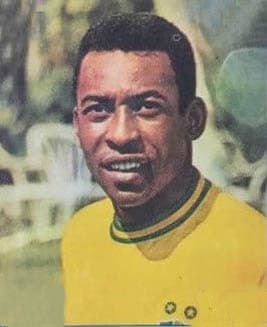
1970 World Cup

Style of play
Pele was relatively short at 5″ 8′, but he more than compensated in terms of speed, power, agility and strength. He was superb with both feet, powerful in the air, great timing and accuracy and an extraordinary perception of the game. He could mesmerise defenders with his eyes and send them the wrong way. He had a scoring ratio of 0.94 goals per game and often rose to the big occasion, scoring at crucial moments in big games. Whilst very competitive, he was also considered to be a fair player with good sense of sportsmanship. A good example was his warm embrace of Bobby Moore, the England caption after England’s defeat in the 1970 World Cup. It is sometimes held up as an embodiment of sportsmanship. Without any doubt, he is universally regarded as the greatest player of the twentieth century – if not all time. He is one of the few sportsman like Muhammad Ali and Usain Bolt, who transcend their sport to become a global icon. French footballer Michel Platini said of Pele.
“There’s Pelé the man, and then Pelé the player. And to play like Pelé is to play like God.
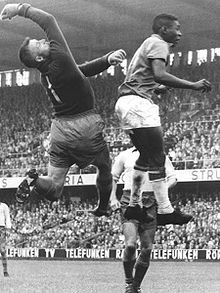
In the domestic league, Pele made his debut for Santos aged just 16. He played for Santos in the Brazilian league from until the 1972-73 season.
Pele finished his career in the lucrative US league. In 1975, he signed for New York Cosmos and played three seasons. He led the New York Cosmos to the US title in 1977 – the year of his retirement.
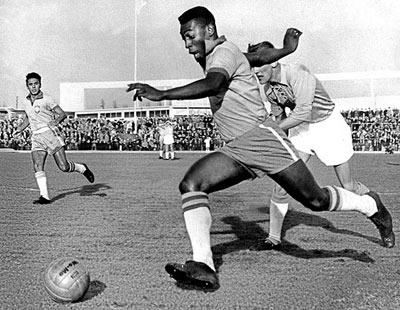
Personal life
Pele was married three times and had several children, some out of wedlock. In 1970, he was investigated by the authoritarian Brazilian government for suspected sympathy to left-wing political prisoners. Pele was investigated for handing out leaflets calling for the release of political prisoners. After the investigation, he did not get involved in politics again.
After retiring has gone on to be a great ambassador for football and sport in general. In 1992, Pelé was appointed a UN ambassador for ecology and the environment. He was also appointed a UNESCO goodwill ambassador. He is not only one of the most gifted footballers of his generation, but, also a mild-mannered man who used his fame and prestige for a positive effect.
Citation: Pettinger, Tejvan . “Biography of Pele”, Oxford, UK. www.biographyonline.net. Last updated 8 March 2020. Originally published 18 April 2010.
Some Highlights of Pele’s Career
- Athlete of the Century , by Reuters News Agency: 1999
- Athlete of the Century , elected by International Olympic Committee: 1999
- UNICEF Football Player of the Century : 1999
- TIME One of the 100 Most Important People of the 20th Century : 1999
- FIFA Player of the Century : 2000

Pele – autobiography at Amazon
Related pages
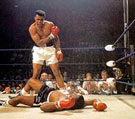
- Share full article
Advertisement
Supported by
Pelé, a Name That Became Shorthand for Perfection
The best gauge of what Pelé meant to soccer is that he was synonymous with excellence even before people saw him play.

By Rory Smith
Of all the myriad things Pelé did — the thousand-plus goals he scored and the array of records he set and the innumerable, immeasurable moments of wonder he conjured — the one that is the most famous, the most familiar, may also have been the most ordinary, the most mundane.
Pelé’s crowning glory was a pass, one played with a nonchalant ease in the fading minutes of the World Cup final in 1970, a moment of glorious, acoustic simplicity from a player whose name had been made and whose legend had been burnished because of his mastery of the impossibly complex.
The pass itself was not easy because of Pelé’s quick, brilliant mind, or because of his flawless technique, or because of the economy of his movement. It was not a pass that he made look easy. It was, by the standards of those who can breathe in the rarefied air of a World Cup final, a pass that was easy.
Standing a few yards outside Italy’s penalty area, he receives the ball from Jairzinho, darting in from the left. Pelé takes one touch to control it, a second to confirm receipt. He takes a third, idly, as he ponders his next move. At no point does he indicate he is in a hurry. He is essentially stationary throughout.
And then, out of the corner of his eye, he sees Carlos Alberto, his captain, charging forward to his right, a single blast of motion in a world of stillness. He waits a beat. Then he plays the pass, almost with a shrug, gently guiding the ball to the exact spot where Carlos Alberto requires it to be so that he can meet it, at full speed, without breaking stride.
That goal did more than seal Brazil’s victory over Italy in the hot, thin air of Mexico City. It did more than make Pelé the only player in history to win three World Cups. It was the ultimate expression of “o jogo bonito,” the beautiful game, soccer not as sport but as art. It was the goal that, forever more, would make Brazil Brazil.
And yet, other than perhaps his poise and arguably his vision, the pass does not display any of the traits that made Pelé Pelé. It does not showcase what The Times of London once referred to as his “feline” movement. It does not prove the assessment of Bobby Moore, the World Cup-winning England captain, that Pelé had “two good feet, [was] magic in the air, quick, powerful, could beat people with skill, could outrun people.” It does not explain why Franz Beckenbauer regarded him as “the most complete player I ever saw,” or convinced Michel Platini that “to play like Pelé is to play like God.”
That the pass has become so indelibly associated with Pelé, of course, is partly because of what the goal came to represent — his masterpiece, Brazil’s masterpiece, the greatest team of all time scoring what was regarded then (and may well be regarded now) as the greatest goal of all time — and partly because of when it was scored.
As the journalist Andrew Downie has observed, it is noteworthy how many of the most lasting images of Pelé come from that World Cup. Aside from his goals in his first final, as a fresh-faced 17-year-old in 1958, it is 1970 that provides the bedrock of evidence for Pelé’s majesty: the elastic header saved by Gordon Banks; the impudent dummy against Uruguay; the shot from the halfway line against Czechoslovakia.
That tournament, though, was already late-era Pelé. He had, by the time he arrived in Mexico, already retired once from Brazil’s national team, dispirited and disheartened after his treatment at the 1966 World Cup in England, when he was subjected to unapologetic and unpunished brutality from opposing defenders. He had already racked up more than a thousand games, condemned to partake in an endless parade of exhibitions as his club, Santos, sought to monetize his fame and pay his salary.
That it should be that version of Pelé that is most readily recalled is not because it represented his pinnacle but because it was the most easily accessible: 1970 was the first World Cup broadcast in vivid Technicolor — those bright yellow jerseys set against rich green fields — and beamed directly into millions of homes around the globe.
Before that, for the vast majority of fans — especially outside Brazil — Pelé had only existed in black-and-white footage. The virtuoso displays that illuminated the 1958 World Cup, the goals that announced him to the world, were consumed by most in grainy news reels played out before the films they had paid to see; the association may, perhaps, have accelerated the perception of Pelé as a star in his own right, but snatched, low-resolution highlights hardly captured his high-definition talent.
Even that, though, was better than the alternative. In 1966, Pelé himself told Pete Axthelm of Sports Illustrated — for a profile of “ The Most Famous Athlete in the World ” who was, at that point, “almost unknown in the United States” — that his finest ever goal, “from a technical standpoint,” had come in a domestic game for Santos against S.C. Juventus in 1959, a year after he became a star.
It had not been filmed. “About 60,000 people saw it,” Axthelm wrote. “About one million will claim to have seen it if you ask them now.” It exists these days only in an eerie, uncanny computer simulation ; whether it is accurate is anyone’s guess.
It is precisely because so many of Pelé’s moments are similarly unavailable that the tendency has grown, in recent years, to try to quantify his achievements: the indisputable three World Cups, but also the rather more contentious, and often dismissed, figure of 1,281 career goals.
To do so, though, strips away process for raw output; it reduces an athlete who defined not only a whole class of player — before Pelé, as Neymar said, “10 was just a number” — but an entire soccer culture to nothing but a productive goal scorer. It makes no room for the inventiveness or the expertise or the sheer joy that were the hallmarks of a player who was cherished as much for how he did things as for what he did.
A far better gauge of Pelé’s legacy would be not those bald, raw numbers but something far less tangible: the scope and the extent of his fame. By 1970, by the time he played that pass, Pelé had been regarded as the best player on the planet — perhaps the best there had ever been — for more than a decade.
He had won and retained that status despite the fact that, outside Brazil, glimpses of him were fleeting, quadrennial, occasional mentions in news bulletins before the pictures. He had retained the World Cup in 1962 but been injured for the tournament’s decisive matches. He had been kicked out of the 1966 tournament in England.
And yet still his name endured. He was famous enough for Sports Illustrated to profile someone the magazine felt its readers would not recognize. He was famous enough that Santos’s exhibition games across the world sold out not just in Europe but in Asia and Africa, too. Axthelm wrote of a crowd of 15,000 waiting to greet him in Abidjan, Ivory Coast; an old legend, one Pelé dismissed, has it that his presence was enough to generate a cease-fire during a civil war in Nigeria.
He was famous, and precious, enough that Brazil’s military government declared him a national treasure to prevent Santos from selling him abroad. A decade later, a club (the New York Cosmos) and a competition (the North American Soccer League) were built around him. He was rivaled for prominence only, contemporaneously, by Muhammad Ali.
Tostão, his old teammate, has said that Brazilian players learn to separate themselves from their identities — that the nicknames by which so many earn their money and their fame become a sort of barrier to protect the individual from the mania that surrounds them. Pelé added a third layer: his nickname, his trademark, became a synonym not for greatness or even for excellence but for an unimpeachable, scarcely attainable form of perfection.
All of that had been built not on what people had seen — other than in those unsteady highlights — but on what they had heard, on what they had read, on what had been passed down to them by word of mouth. It was enough to make opponents relish facing him and to draw fans, thousands upon thousands of them, to his games, meaningless or not.
That might, of course, have been an impossible standard to meet; it is telling, with Pelé, that he consistently met those soaring expectations.
“We went up together to head a ball,” the Italian defender Giacinto Facchetti said after playing him. “I was taller, had a better leap. When I came back down, I looked up in astonishment. Pelé was still there, in the air, heading that ball. It was like he could stay suspended for as long as he wanted to.” Facchetti’s teammate Tarcisio Burgnich was more circumspect. “I told myself he’s made of skin and bones, like everyone else,” he said. “I was wrong.”
The Benfica goalkeeper Costa Pereira met Pelé in the 1962 Intercontinental Cup, the predecessor of the Club World Cup, a meeting between the European and South American champions. “I arrived hoping to stop a great man,” he said. “I went away convinced I had been undone by someone who was not born on the same planet as the rest of us.”
That status had been established by the time Pelé arrived in Mexico for the 1970 World Cup. He had already done everything there was to do: He had scored a thousand goals; he had broken countless records; he had decorated the game with endless moments of wonder. He was the greatest there had ever been.
But that was the first chance that millions had to see him properly, almost for the first time, not just in a hazy glimpse but in full, oversaturated color. That pass, his final act before he was hoisted onto his teammates’ shoulders, the World Cup in his hands, was not especially spectacular. It was not particularly complex. What made it special, though, what makes it last, was his timing. Pelé’s timing was perfect.
Rory Smith is The Times’s chief soccer correspondent, based in Britain. He covers all aspects of European soccer and has reported from three World Cups, the Olympics, and numerous European tournaments. More about Rory Smith
Inside the World of Sports
Dive deeper into the people, issues and trends shaping professional, collegiate and amateur athletics..
Competing for Olympic Spots: Two friends had run side by side for more than 10,000 miles. Both vied for a place in the marathon at the Paris Games .
Captivating New York: It has been 50 years since the Knicks last won the N.B.A. championship. Now, a freshly promising team has enthralled the city .
A Different Kind of Superstar: Nigel Sylvester, one of the world’s most famous BMX riders, has used social media and collaborations to become one of his sport's most recognizable figures .
Americanizing English Soccer: U.S. investors are gobbling up the storied teams of the English Premier League — and changing the stadium experience in ways that soccer fans resent.
A Sense of Home: For generations of immigrants in New York, Sunday soccer at Flushing Meadows Corona Park in Queens is more than a game.
Skills, charisma, mysticism: The life of football legend Pele
The world bids farewell to one of the greatest footballers ever seen.
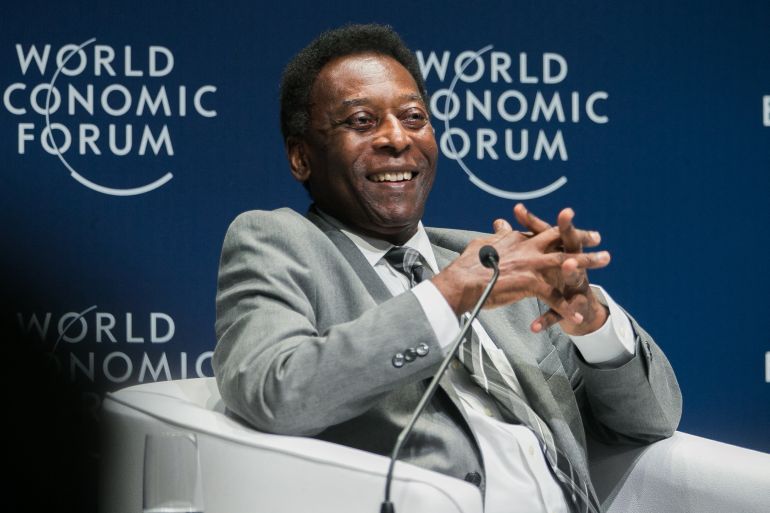
Santos, Brazil – A famous sports writer once said that “if Pelé had not been born a man, he would have been born a football”.
Pelé – real name Edson Arantes do Nascimento – one of the greatest footballers the world had ever seen, died on Thursday at the age of 82.
Keep reading
Brazilian football legend pele dies at age 82, pele, brazilian football ‘phenomenon’, leaves unparalleled legacy, photos: ‘the king’ pele, a lifetime of football memories.
Born in the state of Minas Gerais in 1940, Pelé’s family moved to a nearby city called Bauru looking for a better life. He grew up in poverty and his parents could not even afford a football. An old sock filled with newspapers was the first “ball” his magical feet kicked but it was enough for him to fall in love with the game and for people to start noticing he was different.
When Pelé was 15, a local coach, Waldemar de Brito, took him to play for the football club Santos. Upon arriving in the city that shares the name with the club, Brito told the coach, “This kid will be the best in the world.”
Within minutes, the coach was impressed with Pelé and signed him on the spot. This was 1956. Two years later, Pelé would be in Sweden, spearheading Brazil to a World Cup title, the first of six for the team. He scored two goals in the final against Sweden. He was still 17.
At the final whistle, the wonder kid fainted on the field while being carried by the celebrating crowd.
Pelé was famously easy-going, kind, joyful, and a reliable friend.
“Pelé was always a very nice guy. We would spend so much time talking. He didn’t have any star attitude,” Didi, 84, one of Pelé’s oldest friends and his barber of 55 years, told Al Jazeera.
“I tell my grandchildren that I had one client more famous than anyone else. This is a man who is known more all over the world than Coca Cola. So I feel proud of it and it’s very rare for someone to have a client like this.”
Pelé had a certain way of speaking Portuguese, something he would turn into a trademark. He would constantly finish his sentences with “entende?” which means “understand?”.
It seems he always wanted to make sure to facilitate conversations, just like he would smooth out his teammates’ game.
In addition to skills and charisma, a certain mysticism always surrounded the character of the King of Football. Pelé was from a city called Três Corações, which translates to Three Hearts.
One of his many famous quotes, made at his last match ever played in 1977 in New York, was honouring children and with his limited English, he just said “love, love, love.”
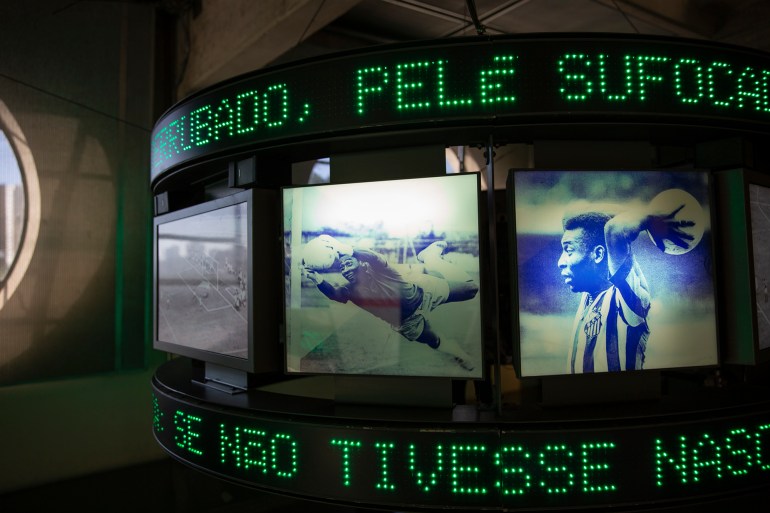
On the pitch, Pelé became an instant celebrity following the 1958 World Cup triumph. Upon returning to Brazil, he helped Santos build a dynasty, winning 25 titles in the 1960s. Despite being world-famous, Pelé kept living a down-to-earth life in Santos. He would share a guest house with other players and cycle around the city.
“The pay was pretty bad but he did it for love of the game and we had so much fun,” Carlos “Lala”, 86, a goalkeeper and Pelé’s former Santos teammate, told Al Jazeera.
Despite being a widely diverse country ethnically, Brazil is not often represented by people of colour. So having someone Black as its biggest celebrity and star had a cultural impact on the country.
Aside from being the world’s best footballer, Pelé also ventured into showbusiness. A lover of music, he recorded an album with Brazilian legendary singer Elis Regina and acted in a handful of movies, making him a pop star as well.
In 1962, Brazil won a second successive World Cup with an injured Pelé supporting the team.
It was in 1970, at the first World Cup broadcasted in colour, that Pelé put the cherry on top of his football legacy. The team that had Clodoaldo, Rivelino and Tostão, put in one of the most celebrated World Cup performances in history.
In the final, a 4-1 win over Italy, Pelé scored a header – the team’s opening goal – that some people said he managed by freezing midair. He celebrated the goal in his typical manner: Jumping and punching the air.
“I told myself before the game that Pelé is made of skin and bones just like everyone else. But I was wrong,” said Tarciso Burnigch, the Italian defender appointed to mark Pelé in the final.
That was Pelé’s 12th and final World Cup goal.
In 1969, he had become the first player to score 1,000 goals. The 1,000th goal was at the Maracanã, in Rio de Janeiro, known as the Mecca of Football.
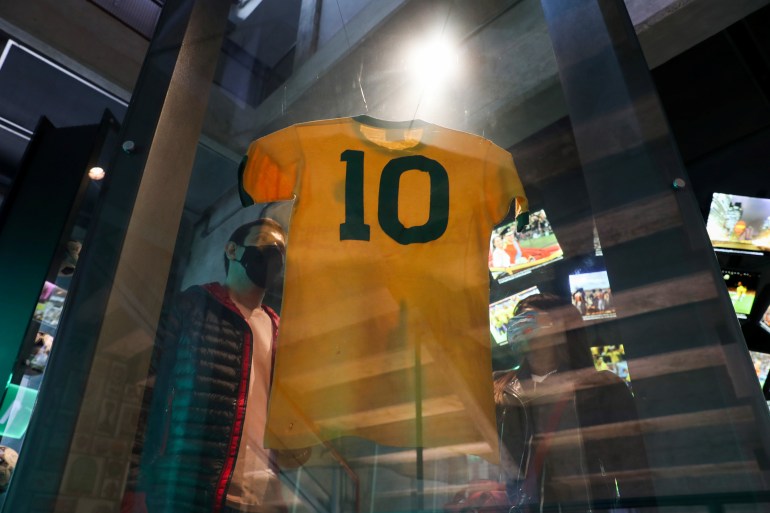
In 1974, he left Santos and played his final years in New York, at a club called Cosmos.
It was the only team he played for other than Santos and Brazil’s national side.
“As we [the security team] were always with the team, traveling, at the games, we had a lot of contact with them, so we developed a friendship,” Pedro de Liberato, Pele’s security guard, and then his neighbour, told Al Jazeera.
“Pelé was always very joyful, always joking with people,” the 90-year-old added.
Pelé wore the number 10 jersey but he did not know which number he would have and was assigned 10 randomly.
The number 10 jersey has since then become associated with the world’s best – Maradona, Roberto Baggio, Zinedine Zidane and Lionel Messi are just some of them who have worn it.
Pelé retired after playing 1,363 games, winning 37 titles, scoring 1,281 goals, including 92 career hat-tricks.
He spent his post-football life involved in social activism, including being a UNESCO goodwill ambassador.
In 1995, he took public office as minister of sports, introducing the legislation that grants players their own rights after a certain age. Pelé also commented on games for television.
In recent years, Pelé struggled with his health. Aside from battling cancer, he also suffered from severe hip pain and spent most of his last years in a wheelchair.

Pelé, Brazilian soccer legend, dies at 82
Brazilian soccer icon Pelé, regarded as the sport’s greatest player, whose wizardry on the pitch helped popularize it as “the beautiful game,” died Thursday after a yearlong bout with cancer.
His daughter confirmed the death on Instagram. “Everything we are is because of you. We love you infinitely. Rest in peace,” Kely Nascimento wrote.
The Brazilian legend , whose real name was Edson Arantes do Nascimento, helped his country win the World Cup in 1958, 1962 and 1970, and he remains the national team’s co-scoring leader, with 77 goals in 92 matches.
Brazil's current superstar, Neymar, tied him at the 2022 Qatar World Cup , scoring his 77th goal in 124 games.
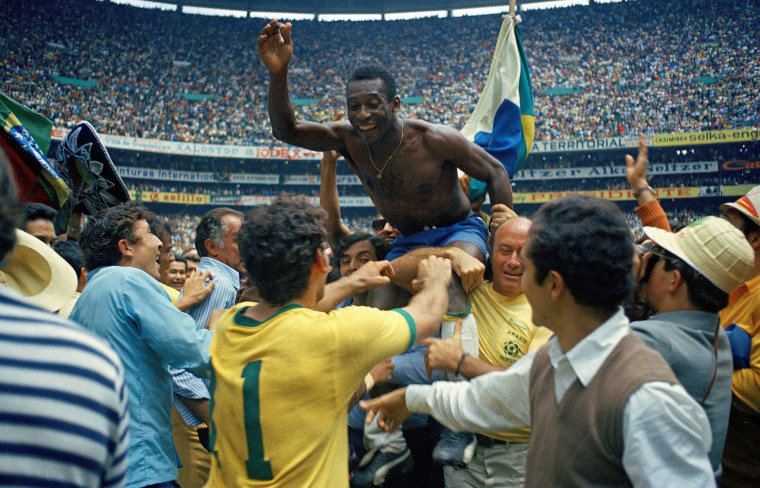
A post on Pelé’s Facebook page said he “enchanted the world with his genius in sport, stopped a war, carried out social works all over the world and spread what he most believed to be the cure for all our problems: love.”
“His message today becomes a legacy for future generations,” the post said.
Pelé became the World Cup's youngest scorer in 1958 when he bagged a goal against Wales in Stockholm at the age of 17 years and 239 days. His record still stands, and he is still the only player under 18 to have scored in a World Cup.
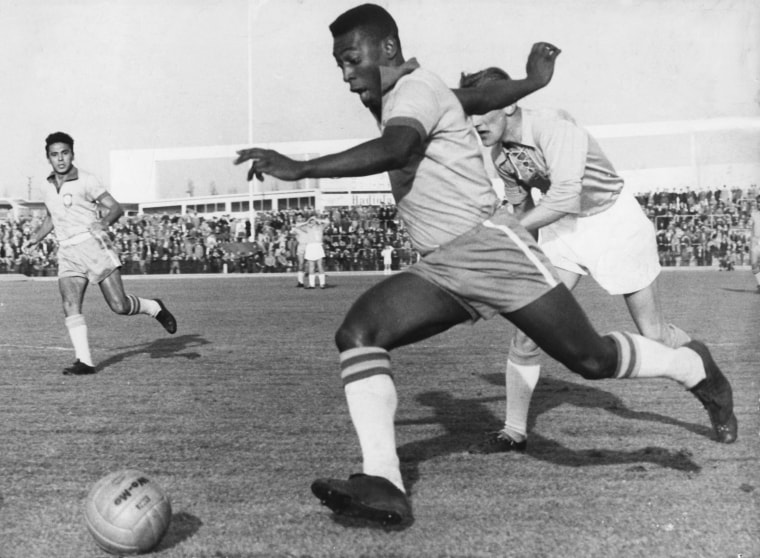
He would also help Brazil triumph in the 1962 tournament in Chile, and, after injury ruled him out of the competition four years later in England, he lit up the Mexico World Cup in 1970.
Speaking to soccer's governing body, FIFA, for Pelé's 80th birthday tribute, Tarcisio Burgnich, an Italian defender in the final that year, admitted that he had struggled against him.
“I told myself before the game, ‘He’s made of skin and bones just like everyone else,’” he said. “But I was wrong.”
Pelé's name and dominance on the pitch came to represent the sport itself.
While North Americans know the game as “soccer” and most of the globe knows it as “football,” virtually everyone agrees it’s “the beautiful game” — or “o jogo bonito” to Brazilians and Portuguese.
While the exact origins of that phrase can be debated, its popularization can be traced to the 1977 biography “Pele, My Life and the Beautiful Game” by Pelé and Robert L. Fish.
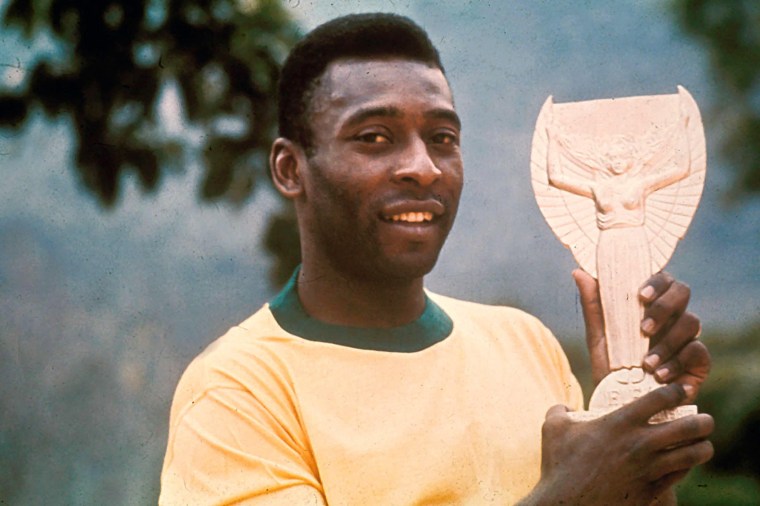
Born into poverty in Brazil’s Minas Gerais state on Oct. 23, 1940, Pelé honed his skills playing with a grapefruit before he signed with the Brazilian team Santos at age 15.
He would go on to great success with the team, winning over 20 major titles, before he signed with the New York Cosmos in the fledgling North American Soccer League in 1975.
Pelé and the Cosmos played a key role in building the sport’s U.S. profile and popularity before he closed out his professional career in 1977.
The glamorous Cosmos, led by aging stars such as Pelé, Franz Beckenbauer and Giorgio Chinaglia, won Soccer Bowl '77 and along the way attracted some of the biggest crowds that had ever seen a soccer match on U.S. soil.
Pelé's Cosmos defeated the Fort Lauderdale Strikers in a playoff match before 77,691 fans at Giants Stadium in East Rutherford, New Jersey. It was the biggest crowd to ever see an NASL match.
The Guinness Book of World Records recognizes Pelé as having scored the most goals during a specified period, with 1,279 in 1,363 games from Sept. 7, 1956, to Oct. 1, 1977.
Such was his acclaim that Pelé transcended the world of sport, becoming a recognizable figure even to those who did not follow the game. He rubbed shoulders with the likes of boxing's Muhammad Ali , Rolling Stones singer Mick Jagger and pop artist Andy Warhol , who created a portrait of him.
“Pelé was one of the few who contradicted my theory: Instead of 15 minutes of fame, he will have 15 centuries,” Warhol said.
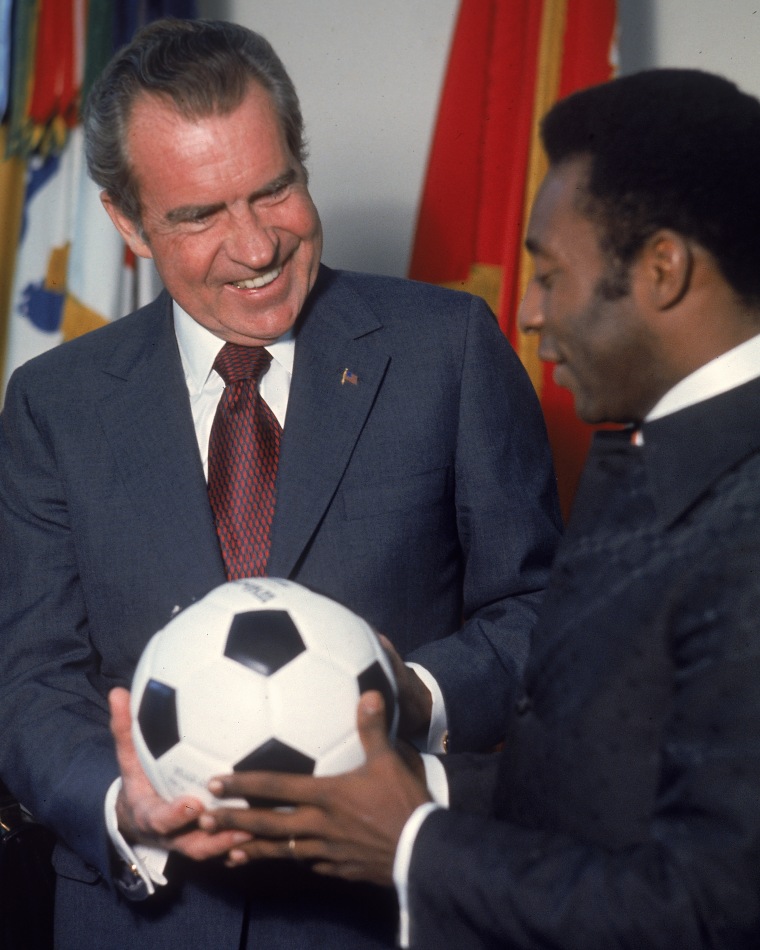
Pelé also was a regular White House visitor, gaining invitations from Presidents Richard Nixon , Gerald Ford , Jimmy Carter and Ronald Reagan .
In 1986, when Reagan invited Pelé for a state dinner in honor of Brazilian President José Sarney, he said: “My name is Ronald Reagan. I’m the president of the United States of America. But you don’t need to introduce yourself because everyone knows who Pelé is.”
After his soccer career ended, Pelé starred in several movies, including “Escape to Victory,” starring Sylvester Stallone and Michael Caine, and several documentaries about his life.
But he was perhaps best known for his ambassadorial work with the United Nations, in which he campaigned against the aggressive marketing of baby milk formulas and on environmental issues, among other causes.
In 1999, he was recognized as one of Time magazine’s “100 Persons of the Century.”
A supporter of various charities throughout his life, he set up the Pelé Foundation in 2018 to help impoverished children.
Married three times, Pelé confessed in a 2021 Netflix documentary named after him that he had so many affairs that he didn’t even know how many children he had.
His seven known offspring include Sandra Machado, whom he refused to acknowledge even after a court-ordered DNA test proved she was his daughter. She would go on to write the book “The Daughter the King Didn’t Want,” before she died in 2006 at 42.
Five other children — Kelly, 55; Edinho, 51; Jennifer, 43; and twins Joshua and Celeste, 25 — came from his first two marriages, to Rosemeri dos Reis Cholbi and Assiria Lemos Seixas. His daughter Flávia Kurtz, 53, was born to Lenita Kurtz in 1968.
In 2016, Pelé married his third wife, Márcia Cibele Aoki, whom he described as his “definitive love” on social media.
Pelé had surgery to remove a colon tumor in September 2021 and had been checking in with the Albert Einstein hospital in the Brazilian city of São Paulo every month since.
The hospital said he was admitted late last month to regulate medication for an infection.
News of his death sent shock waves throughout the sports world and beyond. Former England soccer player Gary Lineker said Pelé was the “ most divine of footballers and joyous of men ,” while Portuguese star Cristiano Ronaldo said a “mere ‘goodbye’ ... will never be enough to express the pain that the entire football world is currently embracing.”
French soccer player Kylian Mbappé said on Twitter : “The king of football has left us but his legacy will never be forgotten. RIP KING.”
Former England star Geoff Hurst said on Twitter that Pelé was "without doubt the best footballer I ever played against."
“For me Pele remains the greatest of all time and I was proud to be on the pitch with him. RIP Pele and thank you,” he tweeted.
André Ceciliano, the state deputy of Rio de Janeiro, called Pelé the “greatest Brazilian sporting idol of all time.”
“Brazil is in mourning,” he said in a tweet . “Thank you for everything.”
Former U.S. President Barack Obama tweeted: "Pelé was one of the greatest to ever play the beautiful game . And as one of the most recognizable athletes in the world, he understood the power of sports to bring people together."
"Our thoughts are with his family and everyone who loved and admired him," he said.
Mithil Aggarwal is a Hong Kong-based reporter/producer for NBC News.
David K. Li is a senior breaking news reporter for NBC News Digital.
- International edition
- Australia edition
- Europe edition
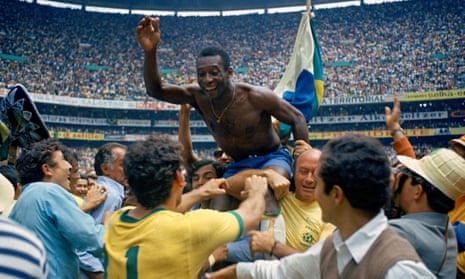
Pelé, Brazil World Cup winner and football legend, dies aged 82
- Pelé scored a world record 1,281 goals in 1,363 games
- Pelé tops our list of the top 100 all-time World Cup footballers
- Observer Archive from 1970: ‘There is only one Pelé’
Pelé, the Brazilian virtuoso whose captivating skill and athleticism ensured he was universally regarded as one of football’s greatest players, has died at the age of 82.
Pelé, who had a colon tumour removed in 2021, was readmitted to Albert Einstein hospital in São Paulo in November amid deteriorating health. A hospital statement on Thursday confirmed the death of “our dear King of Football” at 3.27pm local time, “due to the failure of multiple organs, a result of the progression of cancer of colon associated with his previous clinical condition.”
A statement from Pelé’s official Instagram page added: “Inspiration and love marked the journey of King Pelé, who peacefully passed away today. On his journey, Edson enchanted the world with his genius in sport, stopped a war, carried out social works all over the world and spread what he most believed to be the cure for all our problems: love. His message today becomes a legacy for future generations. Love, love and love, forever.”
After reports he was receiving end-of-life care, Pelé said he felt “strong, with a lot of hope” in a social media post on 3 December. A further statement from the hospital on 21 December reported that Pelé “requires further care related to renal and cardiac dysfunctions” after the “progression” of his colon cancer. Social media posts from his daughter Kely Nascimento showed that family members had gathered at the hospital to spend Christmas with him.
Brazil’s joint all-time record scorer won three World Cups as a player, in 1958, 1962 and 1970, over a 14-year international career that included 77 goals in 92 appearances for his country. Nicknamed “the Black Pearl” and “the King”, Pelé was one of only three players to have scored in four World Cups. In 1,363 games, he scored 1,281 goals, at the time of his retirement in 1977 more than twice as many as his nearest challenger.
It was the 1970 World Cup triumph for which he will be best celebrated, the linchpin of a beguiling team that included Carlos Alberto, Jairzinho, Gérson, Tostão and Rivelino that swept through Mexico, his canary yellow No 10 shirt becoming an icon of the sport.
World Soccer described Brazil’s 1970 winners as “more than a team”, adding: “The Brazilian side that won the 1970 World Cup in such style have become a myth, a team to be held up as the ultimate exponents of the beautiful game.” Pelé was their figurehead and inspiration.
Brazil’s government declared three days of mourning and the arch at Wembley Stadium was lit in the colours of Brazil, while icons of sport and heads of state bowed to the man who rose up from childhood poverty to become a legend.
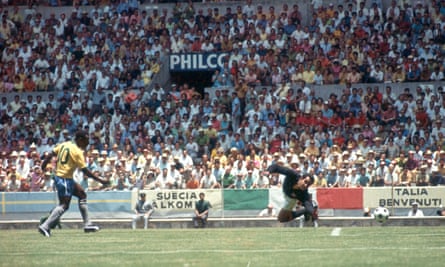
Born Edson Arantes do Nascimento on 23 October 1940, Pelé began his professional career at 15 and made his international debut a year later. In 1999, he was voted player of the century in a poll of Ballon d’Or winners and Time magazine named him as one of 100 most influential people of the 20th century.
In his prime, Pelé’s celebrity was such that he gained audiences with popes and heads of state, his allure so great that when the ill-fated New York Cosmos sought a marquee name to launch a soccer assault on America, Pelé was one of the very few footballers to be recognised by the wider American public in the 1970s.
Pelé previously underwent surgery in November 2012, having a hip replacement at a time when he was struggling to cope with life on the road, and had since suffered a urinary infection after having kidney surgery for the removal of stones.

In recent years Pelé had reduced his personal appearances, including in February 2020 when he did not attend a ceremony to unveil a statue of him representing the 1970 World Cup-winning team because of mobility problems that led to the Brazilian using walkers and wheelchairs in public.
João Saldanha, the coach who helped shape that 1970 side, once said: “Ask me who is the best right-back in Brazil, and I’ll say Pelé. Ask me about the best left-back or midfield man, or the best centre-forward. Always I must say Pelé. If he wants to be goalkeeper, he will be. There is only one Pelé.”
Brazil’s president-elect, Luiz Inácio Lula da Silva, said: “I had the privilege that younger Brazilians didn’t have: I saw Pele play, live, at Pacaembu and Morumbi. Play, no – I saw Pele give a show.
“Because when he got the ball he always did something special, which often ended up in a goal.”
Former Brazilian president Dilma Rousseff wrote: “Thank you for the joy you gave the Brazilian people and the people of the world. No one has been a king so loved.”
- Brazil (Football)
- Brazil (World news)
Comments (…)
Most viewed.
- Election 2024
- Entertainment
- Newsletters
- Photography
- Personal Finance
- AP Investigations
- AP Buyline Personal Finance
- AP Buyline Shopping
- Press Releases
- Israel-Hamas War
- Russia-Ukraine War
- Global elections
- Asia Pacific
- Latin America
- Middle East
- Election Results
- Delegate Tracker
- AP & Elections
- Auto Racing
- 2024 Paris Olympic Games
- Movie reviews
- Book reviews
- Personal finance
- Financial Markets
- Business Highlights
- Financial wellness
- Artificial Intelligence
- Social Media
Pelé, Brazil’s mighty king of ‘beautiful game,’ has died
Brazilian soccer legend Pelé has died in São Paulo at the age of 82.
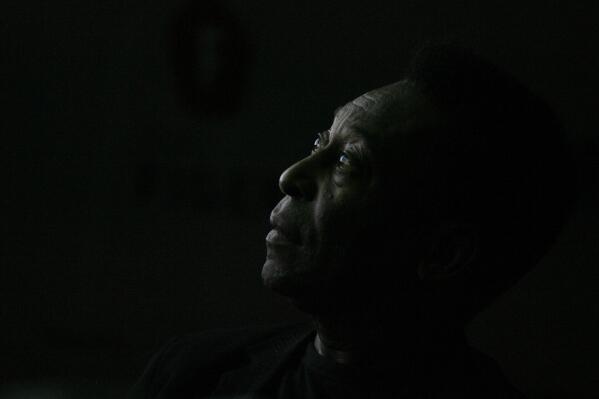
FILE - Brazil’s soccer legend Pele attends the opening of an exhibit about his life titled King’s Marks, in Brasilia, Brazil, June 25, 2008. Pelé, the Brazilian king of soccer who won a record three World Cups and became one of the most commanding sports figures of the last century, died in Sao Paulo on Thursday, Dec. 29, 2022. He was 82. (AP Photo/Eraldo Peres, File)
- Copy Link copied
FILE - Brazil’s Pele wears his national team’s jersey in Rio de Janeiro, Brazil, May 25, 1962. Pelé, the Brazilian king of soccer who won a record three World Cups and became one of the most commanding sports figures of the last century, died in Sao Paulo on Thursday, Dec. 29, 2022. He was 82. (AP Photo, File)
FILE - Brazilian soccer legend Pele smiles during a media opportunity at a restaurant in London, March 20, 2015. Pelé, the Brazilian king of soccer who won a record three World Cups and became one of the most commanding sports figures of the last century, died in Sao Paulo on Thursday, Dec. 29, 2022. He was 82. (AP Photo/Kirsty Wigglesworth, File)
FILE - Soccer star Pele, of the New York Cosmos, listens to the star-spangled banner prior to a playoff game between the Cosmos and the Rochester Lancers in Giants Stadium, East Rutherford, New Jersey, Aug. 24, 1977. Pelé, the Brazilian king of soccer who won a record three World Cups and became one of the most commanding sports figures of the last century, died in Sao Paulo on Thursday, Dec. 29, 2022. He was 82. (AP Photo/Ray Stubblebine, File)
FILE - Brazil’s Pele is hoisted on the shoulders of his teammates after Brazil won the World Cup final against Italy, 4-1, in Mexico City’s Estadio Azteca, June 21, 1970. Pelé, the Brazilian king of soccer who won a record three World Cups and became one of the most commanding sports figures of the last century, died in sao Paulo on Thursday, Dec. 29, 2022. He was 82. (AP Photo, File)
FILE - Argentine soccer star Diego Armando Maradona, left, rests in a hammock with Brazilian soccer star Pele, during a meeting in Rio de Janeiro, Brazil, May 13, 1995. Pelé, the Brazilian king of soccer who won a record three World Cups and became one of the most commanding sports figures of the last century, died in Sao Paulo on Thursday, Dec. 29, 2022. He was 82. (AP Photo/G. Copolla, File)
FILE - Brazilian soccer star Pele relaxes after a workout in Santos, Brazil, June 3, 1975. Pelé, the Brazilian king of soccer who won a record three World Cups and became one of the most commanding sports figures of the last century, died in Sao Paulo on Thursday, Dec. 29, 2022. He was 82. (AP Photo, File)
FILE - Soccer superstar Pele, waving the flags of Brazil and the U.S., is carried off the field in driving rain by players of both teams at Giants Stadium in East Rutherford, N.J., after his final game, Oct. 1, 1977. Pelé, the Brazilian king of soccer who won a record three World Cups and became one of the most commanding sports figures of the last century, died in Sao Paulo on Thursday, Dec. 29, 2022. He was 82. (AP Photo/Richard Drew, File)
FILE - Brazilian soccer legend Pele waves prior to the African Cup of Nations final soccer match between Ivory Coast and Zambia at Stade de L’Amitie in Libreville, Gabon, Feb. 12, 2012. Pelé, the Brazilian king of soccer who won a record three World Cups and became one of the most commanding sports figures of the last century, died in Sao Paulo on Thursday, Dec. 29, 2022. He was 82. (AP Photo/Francois Mori, File)
FILE - Brazil’s Pele scores past Venezuela’s goal keeper Fabrizio Fasano in Rio de Janeiro, Brazil, Aug. 24, 1969. Pelé, the Brazilian king of soccer who won a record three World Cups and became one of the most commanding sports figures of the last century, died in Sao Paulo on Thursday, Dec. 29, 2022. He was 82. (AP Photo, File)
FILE - Soccer player Pele embraces boxer Muhammad Ali during a ceremony honoring the Brazilian soccer star of the New York Cosmos at Giants Stadium, East Rutherford, N.J., Oct. 1, 1977. Pelé, the Brazilian king of soccer who won a record three World Cups and became one of the most commanding sports figures of the last century, died in Sao Paulo on Thursday, Dec. 29, 2022. He was 82. (AP Photo/Richard Drew, File)
FILE - Brazil’s soccer star Pele bicycle kicks a ball during a game at unknown location, Sept. 1968. Pelé, the Brazilian king of soccer who won a record three World Cups and became one of the most commanding sports figures of the last century, died in Sao Paulo on Thursday, Dec. 29, 2022. He was 82. (AP Photo File)
FILE - Brazil’s 17-year-old Pele weeps on the shoulder of goalkeeper Gylmar Dos Santos Neves after Brazil’s 5-2 victory over Sweden in the final of the soccer World Cup in Stockholm, Sweden, June 29, 1958. Pelé, the Brazilian king of soccer who won a record three World Cups and became one of the most commanding sports figures of the last century, died in Sao Paulo on Thursday, Dec. 29, 2022. He was 82. (AP Photo File)
FILE - Pele reacts after heading the ball during a soccer match between the Cosmos and the Toronto Metro-Croatia in New York’s Downing Stadium, June 19, 1975. Pelé, the Brazilian king of soccer who won a record three World Cups and became one of the most commanding sports figures of the last century, died in Sao Paulo on Thursday, Dec. 29, 2022. He was 82. (AP Photo/ Richard Drew, File)
FILE - Brazilian soccer star Pele waves to admirers, as he and his bride Rosemeri ride in a traditional horse-drawn carriage as they tour Salzburg, Austria, Feb. 25, 1966. Pelé, the Brazilian king of soccer who won a record three World Cups and became one of the most commanding sports figures of the last century, died in Sao Paulo on Thursday, Dec. 29, 2022. He was 82. (AP Photo/Klaus Frings, File)
FILE - Brazilian soccer star Pele and his wife Rosemeri pose for a photo with their daughter Kelly, in an unknown location, June 1967. Pelé, the Brazilian king of soccer who won a record three World Cups and became one of the most commanding sports figures of the last century, died in Sao Paulo on Thursday, Dec. 29, 2022. He was 82. (AP Photo, File)
FILE - Brazilian soccer great Pele, and English soccer star David Beckham pose for photos during a U.S. Soccer Foundation fundraising gala, in New York, March 19, 2008. Pelé, the Brazilian king of soccer who won a record three World Cups and became one of the most commanding sports figures of the last century, died in Sao Paulo on Thursday, Dec. 29, 2022. He was 82. (AP Photo/Jason DeCrow, File)
FILE - Brazilian soccer star Pele, his wife Rosemeri pose for a photo with their daughter Kelly, and newborn son Edson, in an unknown location in Brazil in 1976. Pelé, the Brazilian king of soccer who won a record three World Cups and became one of the most commanding sports figures of the last century, died in Sao Paulo on Thursday, Dec. 29, 2022. He was 82. (AP Photo File)
FILE - Brazil’s soccer legend Pele greets the crowd ahead of a Spanish league soccer match, in the Santiago Bernabeu stadium in Madrid, Jan. 16, 2005. Pelé, the Brazilian king of soccer who won a record three World Cups and became one of the most commanding sports figures of the last century, died in Sao Paulo on Thursday, Dec. 29, 2022. He was 82. (AP Photo/Jasper Juinen, File)
FILE - Brazilian soccer legend Pele is pushed in a wheelchair as he arrives at the 2018 World Cup soccer draw at the Kremlin in Moscow, Dec. 1, 2017. Pelé, the Brazilian king of soccer who won a record three World Cups and became one of the most commanding sports figures of the last century, died in Sao Paulo on Thursday, Dec. 29, 2022. He was 82. (AP Photo/Ivan Sekretarev, File)
FILE - Soccer player Neymar, left, and Brazalian soccer legend Pele, share a laugh during a centennial anniversary celebration of the team in Santos, Brazil. Pelé, the Brazilian king of soccer who won a record three World Cups and became one of the most commanding sports figures of the last century, died in Sao Paulo on Thursday, Dec. 29, 2022. He was 82. (AP Photo/Nelson Antoine, File)
FILE - Pele gives a soccer demonstration during the taping of the Johnny Carson Show at NBC-TV studios in New York, May 9, 1973. Pelé, the Brazilian king of soccer who won a record three World Cups and became one of the most commanding sports figures of the last century, died in Sao Paulo on Thursday, Dec. 29, 2022. He was 82. (AP Photo, File)
FILE - Brazilian soccer star Pele, and New York Cosmos coach Julio Mazzei, embrace at Giants Stadium in East Rutherford, N.J., April 16, 1982. Mazzei helped persuaded Pele to play in the United States and coached the Cosmos to a North American Soccer League title in 1982. Pelé, the Brazilian king of soccer who won a record three World Cups and became one of the most commanding sports figures of the last century, died in Sao Paulo on Thursday, Dec. 29, 2022. He was 82. (AP Photo/Seth Rubenstein, File)
FILE - Brazilian soccer great Pele poses with Paul Kemsley, second right, chairman of the New York Cosmos, during a press conference in Hong Kong, March 7, 2011. Pele was in here to promote the rebirth of the Cosmos, hoping for the team to begin play in 2014. Pelé, the Brazilian king of soccer who won a record three World Cups and became one of the most commanding sports figures of the last century, died in Sao Paulo on Thursday, Dec. 29, 2022. He was 82. (AP Photo/Vincent Yu, File)
FILE - Pele is carried off the Giants Stadium field by his New York Cosmos teammates after his final soccer game, in East Rutherford, New Jersey, Oct. 1, 1977. Smiling and looking up at Pele are Giorgio Chinaglia of Italy and Erol Yasin of Turkey, center. Pelé, the Brazilian king of soccer who won a record three World Cups and became one of the most commanding sports figures of the last century, died in Sao Paulo on Thursday, Dec. 29, 2022. He was 82. (AP Photo/Bill Kostroun, File)
SAO PAULO (AP) — Pelé, the Brazilian king of soccer who won a record three World Cups and became one of the most commanding sports figures of the last century, died Thursday. He was 82.
The standard-bearer of “the beautiful game” had undergone treatment for colon cancer since 2021. The medical center where he had been hospitalized for the last month said he died of multiple organ failure as a result of the cancer.
“Pelé changed everything. He transformed football into art, entertainment,” Neymar, a fellow Brazilian soccer star, said on Instagram. “Football and Brazil elevated their standing thanks to the King! He is gone, but his magic will endure. Pelé is eternal!”
A funeral was planned for Monday and Tuesday, with his casket to be carried through the streets of Santos, the coastal city where his storied career began, before burial.
Widely regarded as one of soccer’s greatest players , Pelé spent nearly two decades enchanting fans and dazzling opponents as the game’s most prolific scorer with Brazilian club Santos and the Brazil national team.
His grace, athleticism and mesmerizing moves transfixed players and fans. He orchestrated a fast, fluid style that revolutionized the sport — a samba-like flair that personified his country’s elegance on the field.
He carried Brazil to soccer’s heights and became a global ambassador for his sport in a journey that began on the streets of Sao Paulo state, where he would kick a sock stuffed with newspapers or rags.
In the conversation about soccer’s greatest players, only the late Diego Maradona, Lionel Messi and Cristiano Ronaldo are mentioned alongside Pelé.
Different sources, counting different sets of games, list Pelé’s goal totals anywhere between 650 (league matches) and 1,281 (all senior matches, some against low-level competition.)
The player who would be dubbed “The King” was introduced to the world at 17 at the 1958 World Cup in Sweden, the youngest player ever at the tournament. He was carried off the field on teammates’ shoulders after scoring two goals in Brazil’s 5-2 victory over the host country in the final.
Injury limited him to just two games when Brazil retained the world title in 1962, but Pelé was the emblem of his country’s World Cup triumph of 1970 in Mexico. He scored in the final and set up Carlos Alberto with a nonchalant pass for the last goal in a 4-1 victory over Italy.
The image of Pelé in a bright, yellow Brazil jersey, with the No. 10 stamped on the back, remains alive with soccer fans everywhere. As does his trademark goal celebration — a leap with a right fist thrust high above his head.
Pelé’s fame was such that in 1967 factions of a civil war in Nigeria agreed to a brief cease-fire so he could play an exhibition match in the country. He was knighted by Britain’s Queen Elizabeth II in 1997. When he visited Washington to help popularize the game in North America, it was the U.S. president who stuck out his hand first.
“My name is Ronald Reagan, I’m the president of the United States of America,” the host said to his visitor. “But you don’t need to introduce yourself because everyone knows who Pelé is.”
Pelé was Brazil’s first modern Black national hero but rarely spoke about racism in a country where the rich and powerful tend to hail from the white minority.
Opposing fans taunted Pelé with monkey chants at home and all over the world.
“He said that he would never play if he had to stop every time he heard those chants,” said Angelica Basthi, one of Pelé’s biographers. “He is key for Black people’s pride in Brazil, but never wanted to be a flagbearer.”
Pelé’s life after soccer took many forms. He was a politician -- Brazil’s Extraordinary Minister for Sport -- a wealthy businessman, and an ambassador for UNESCO and the United Nations.
He had roles in movies, soap operas and even composed songs and recorded CDs of popular Brazilian music.
As his health deteriorated, his travels and appearances became less frequent. He was often seen in a wheelchair during his final years and did not attend a ceremony to unveil a statue of him representing Brazil’s 1970 World Cup team. Pelé spent his 80th birthday isolated with a few family members at a beach home.
Born Edson Arantes do Nascimento, in the small city of Tres Coracoes in the interior of Minas Gerais state on Oct. 23, 1940, Pelé grew up shining shoes to buy his modest soccer gear.
Pelé’s talent drew attention when he was 11, and a local professional player brought him to Santos’ youth squads. It didn’t take long for him to make it to the senior squad.
Despite his youth and 5-foot-8 frame, he scored against grown men with the same ease he displayed against friends back home. He debuted with the Brazilian club at 16 in 1956, and the club quickly gained worldwide recognition.
The name Pelé came from him mispronouncing the name of a player called Bilé .
He went to the 1958 World Cup as a reserve but became a key player for his country’s championship team. His first goal, in which he flicked the ball over the head of a defender and raced around him to volley it home, was voted as one of the best in World Cup history.
The 1966 World Cup in England — won by the hosts — was a bitter one for Pelé, by then already considered the world’s top player. Brazil was knocked out in the group stage and Pelé, angry at the rough treatment, swore it was his last World Cup.
He changed his mind and was rejuvenated in the 1970 World Cup. In a game against England, he struck a header for a certain score, but the great goalkeeper Gordon Banks flipped the ball over the bar in an astonishing move. Pelé likened the save — one of the best in World Cup history — to a “salmon climbing up a waterfall.” Later, he scored the opening goal in the final against Italy, his last World Cup match.
In all, Pelé played 114 matches with Brazil, scoring a record 95 goals, including 77 in official matches.
His run with Santos stretched over three decades until he went into semi-retirement after the 1972 season. Wealthy European clubs tried to sign him, but the Brazilian government intervened to keep him from being sold, declaring him a national treasure.
On the field, Pelé’s energy, vision and imagination drove a gifted Brazilian national team with a fast, fluid style of play that exemplified “O Jogo Bonito” -- Portuguese for “The Beautiful Game.” His 1977 autobiography, “My Life and the Beautiful Game,” made the phrase part of soccer’s lexicon.
In 1975, he joined the New York Cosmos of the North American Soccer League. Although 34 and past his prime, Pelé gave soccer a higher profile in North America. He led the Cosmos to the 1977 league title and scored 64 goals in three seasons.
Pelé ended his career on Oct. 1, 1977, in an exhibition between the Cosmos and Santos before a crowd in New Jersey of some 77,000. He played half the game with each club. Among the dignitaries on hand was perhaps the only other athlete whose renown spanned the globe — Muhammad Ali.
Pelé would endure difficult times in his personal life, especially when his son Edinho was arrested on drug-related charges. Pelé had two daughters out of wedlock and five children from his first two marriages, to Rosemeri dos Reis Cholbi and Assiria Seixas Lemos. He later married businesswoman Marcia Cibele Aoki.
Azzoni reported from Madrid.
AP sports: https://apnews.com/hub/sports and https://twitter.com/AP_Sports

Pele Biography Facts, Childhood, Career, Personal Life
Edson Arantes do Nascimento (born 23 October 1940) popularly known as Pele, is a retired Brazilian footballer who played football professionally for 21 years. During those years, Pele established himself as the best in the world, and to date, only a very few players have carried the same momentum as Pele did during his football days. Pele is regarded by pundits as one of the best players in the history of football. From his youth to his retirement, Pele was a sight to behold on the pitch. Even after his exit from the pitch, Pele still remains a noteworthy figure in football as his performance is often used as a sort of benchmark for young stars dominating football in the modern age. In this article on Pele biography facts, childhood, career and personal life, we’ll review the life of the football legend
Table of Contents
Pele’s Biography Facts, Age, Quick Info
Here are some quick facts that you need to know about the retired Brazilian football legend.
- Full Name: Edson Arantes do Nascimento
- Nicknames: Pele, Dico
- Date of Birth: 23 October 1940
- Age: 83 years old
- Place of Birth: Três Corações, Brazil
- Nationality: Brazilian
- Zodiac sign: Libra
- Height: 5 ft 8 in (1.73 m)
- Weight: 73 kg
- Father: João Ramos do Nascimento
- Mother: Celeste Arantes
- Siblings: Zeca Nascimento (brother), Maria Lúcia Nascimento (sister)
- Wife: Marcia Aoki (married 2014)
- Sons: Edson Cholbi Nascimento, Joshua Nascimento
- Daughters: Sandra Regina Arantes do Nascimento, Kelly Cristina Nascimento, Flávia Christina Kurtz Nascimento, Celeste Nascimento, Jennifer Nascimento, Sandra Machado
Pele’s Early Life & Childhood
Edson Arantes do Nascimento is the eldest of two children born on 23 October 1940, to Dondinho and Celeste Arantes in Três Corações located in Brazil. Pele whose father was a footballer grew up in a poverty affected area, precisely in Bauru in Brazil. He was named after the renowned inventor, Thomas Edison. His parents decided to remove the ‘i’ in his name. But mistakes made in his birth certificate showed his name as Edison.
Edson Arantes got the moniker ‘Pele’ after he mispronounced the name of a player he adored, goalkeeper of Vasco da Gama, Bilé. After he repeatedly mispronounced the name, he was named Pele, and despite efforts to make his peers stop calling his nickname, they continued and thus the name stuck.
Pele was trained to play football by his father. But because he could not afford a ball, he placed socks in newspaper and attached it a string or grapefruit. As he grew Pele joined local football teams such as Bauru Athletic Club juniors, where he went on to win two Sao Paulo Youth Championship. He played in various local football competitions against adults and in one of those competitions, despite concerns that he was too young, Pele dominated and thus ended up as the tournament top scorer.
Pele’s Professional Football Career
Santos fc (1956–1974).
- Appearances: 638
Pele’s coach at youth team Bauru Athletic Club juniors, Waldemar de Brito, took 15 years old Pele to a tryout for Santos FC. Brito told Santos executive that Pele will be the greatest player in the world. Pele convinced Santos coach during the tryout and he signed a contract with the club. Santos prided Pele as a star to the media and he confirmed that by his performance.
Following the 1962 World Cup, where Pele was amazingly brilliant, top European clubs such as Real Madrid tried to sign him. Inter Milan succeeded in getting a regular contract with him, but following the intense protest of Santos fan, former owner of Inter Milan, Angelo Moratti tore the contract following the request of Santos coach. Pele’s popularity was so much that the government, especially, ex-President, Jânio Quadro declared Pele a national treasure, so as to prevent him from bing transferred away from Brazil.
He earned his first trophy with Santos in 1958, the Campeonato Paulista. He finished as the tournament top scorer with 58 goals, a record which has not been broken till date. He continued in top form, helping Santos claim several trophies. In 1962, he won the first most prestigious title in South America, the Copa Libertadores. He went on to win the title the next year, but following the 1964 Copa Libertadores, Santos began experiencing a decline in form but Pele’s form remained intact. Despite the fact that Pele was not playing in top European leagues, his fame was widely proclaimed. In 1967, at the height of the Civil war in Nigeria, a ceasefire was announced for 48 hours, just to watch Pele play an exhibition game in Lagos, Nigeria.
New York Cosmos (1975–1977)
- Appearances: 56
After playing for 19 seasons for Santos, he retired from Brazilian club football in 1974, but two years later, he went on to play for New York Cosmos in the North American Soccer League (NASL). Pele’s presence in America increased interest in football in America. While he played for Cosmos, he played in exhibition matches in various countries such as in Lebanon, weeks before the Civil war began. He played for Nejmeh against the Lebanese league stars. About 40,000 gathered to watch the game. In his final season at Cosmos, he led his team to win the NASL championship. As he decided to retire from football, an exhibition match was held between Santos and Cosmos in front of a sold-out crowd at the Giants stadium.
Pele’s International Career
Brazil national team (1957–1971).
- Appearances: 77
At the age of 16, Pele earned his first international goal and thus became Brazil youngest goalscorer, a record he still holds. At the 1958 World Cup, Pele was the youngest in the tournament and had performed brilliantly helping Brazil trash Sweden 5-1 in the final. He became the youngest player to play in the final of a world cup and was named the tournament’s best young player. He was granted the no. 10 jersey in the tournament following disorganisation which led FIFA to hand out jersey numbers.
At the 1959 South American Championship, he was in amazing form as he emerged the best and top scorer in the tournament. In the 1962 World Cup, he was in astounding form as he led Brazil to another World Cup title. In the 1966 World Cup, Brazil was not successful, but Pele who was in amazing form became the first player to score in three successive World Cup tournaments. In a game against Portugal which Brazil lost, Pele was subject to fouls, but the referee did not send the player off, which led him to declare he’ll no longer play football again, a decision he later rescinded.
In the 1970 World Cup, Pele who initially refused to play in the tournament led Brazil to victory once again. In the final of the tournament, Pele was involved in what is known as the greatest team goal history. He was awarded the Golden ball title. He played his last International game against Yugoslavia in Rio de Janeiro in 1971.
Pele’s Personal Life, Wife, Marriages
Pele has been unsuccessful in two marriages. He married Rosemeri dos Reis Cholb in February 1966. The couple who divorced in 1982, gave birth to three children. The Union’s only son, Edson Cholbi Nascimento, a former goalkeeper was convicted of money laundering from drug trafficking and was sentenced to 33 years in prison, which was later reduced to 12 years. In 1994, Pele got married to Assíria Lemos Seixas, and they gave birth to twins in 1996. In 2008, they divorced. In 2016, he got married to Marcia Aoki.
Pele is said to be the father to Sandra Machado, the daughter of a housemaid, who Pele had relations with. Pele refused to submit to DNA testing and also refused to acknowledge that he was her father even after her death in 2006. Courts, however, ruled that he is her father. In 1970, the Brazilian Military dictatorship investigated him for sympathies towards the leftist.
In 1976, a coup occurred in Nigeria and Pele was in the country on a trip which was sponsored by Pepsi. He went on to stay at the residence of the Brazilian ambassador before he left the country disguised in pilot’s clothing.
Pele’s right kidney was removed in 1977. In 2019, Pele had urinary tract infection.
In 2020, his son, Edson, revealed he could no longer walk.
SEE MORE: Biography facts, early-life, careers and personal life of famous footballers .
Facts Check
At SportyTell.com, we strive for fairness and accuracy.
If you have concerns about something that doesn’t look right in this Pele Biography Facts, Childhood, Career, Personal Life, please don’t hesitate to contact us .
About The Author
SportyTell Editors
This article was created by a combination of a few writers and editors from Sporty Tell. It's not rare for our writers and team members to collaborate and work together to create the articles you read on the site. This is just one of these examples. This is why you don't see just one author for this article.
Related Posts
Pele, the king of football
- Quality Automatic Automatic HD
- Speed Normal
- Subtitle Options
- Font family Default
- Font color Default
- Font opacity Default
- Font size Default
- Background color Default
- Background opacity Default
- Window color Default
- Window opacity Default
- Character edge style Default
- Monospaced Serif
- Proportional Serif
- Monospaced Sans-Serif
- Proportional Sans-Serif
- Drop Shadow
- , selected descriptions off
This is a modal window.
- Powered by THEOplayer 2023.3.0
The world of football has lost its king with the news that the great Pele passed away at the age of 82.
Pele has passed away aged 82
His death comes following a lengthy battle with cancer
With three titles to his name, the great Brazilian won more World Cups than any other player in history
Edson Arantes do Nascimento, or Pele as he was known and loved, passed away on 29 December aged 82 in Sao Paulo following a lengthy battle with cancer. He is considered by many to be the greatest footballer of all time. After several months of debilitating cancer treatment, Pele was admitted to the Hospital Israelita Albert Einstein in Sao Paulo on Wednesday 30 November with a respiratory tract infection.
In September 2021, when the Brazilian was undergoing routine examinations previously postponed due to the COVID-19 pandemic, practitioners identified a tumour on his right colon that required surgery. Since the operation, Pele had been in and out of hospital, including for chemotherapy.
Most decorated World Cup player in history Most decorated World Cup player in history
The death of Brazil’s former No10 occurred shortly after the FIFA World Cup, a tournament that propelled him to legendary status in the sport. Aged just 17, Pele was named in the Brazil squad that travelled to Sweden in 1958, playing a crucial role in A Seleção’s first ever World Cup triumph. The teenager scored six goals at that edition, including a brace in his side’s 5-2 victory over Sweden in the Final. Although still only 21, Pele was arguably at his technical peak four years later at Chile 1962, where he scored another World Cup goal. Unfortunately, a thigh muscle tear in Brazil’s second group game forced him to watch the rest of the tournament from the sidelines, as the South Americans retained their world title. Pele then went on to score his eighth World Cup goal at England 1966, a tournament that ended prematurely for A Seleção following their loss to Portugal and resulting group-stage exit. Many of his critics, including back home, thought his career was over, but he would have his redemption at his final World Cup appearance four years later. The Santos legend led an historic Auriverde side at Mexico 1970, a team that many experts regard as the greatest ever Brazilian XI. Pele scored four times at the tournament, including one in the Final against Italy at the Estadio Azteca. Brazil and Pele had claimed their record third World Cup crown, winning seven consecutive games with their famous jogo bonito. The player known as 'O Rei' ('The King') also managed to end his international career with 12 World Cup goals to his name. From that moment on, the country’s football was divided into two eras: pre- and post-Pele. Brazilians spent the following decades debating who was their next best player. Opinion is divided on whether Garrincha, Rivellino, Zico, Romario, Ronaldo, Ronaldinho or Neymar is the second-best Brazilian footballer of all time, but Pele will always be considered the greatest.
Santos, the USA and off the field Santos, the USA and off the field
Unlike many players of his generation, Pele never made the move to a big European club, instead spending most of his career at Santos. The forward played across the world with the Alvinegro and was part of their greatest ever team, winning back-to-back Copa Libertadores and Intercontinental Cups in 1962 and 1963. The footballing icon then moved to the USA, becoming one of the early driving forces behind the sport’s growing popularity in the country. Pele played for New York Cosmos between 1975 and 1977, drawing huge crowds to American stadiums. He also made a name for himself in pop culture at the time, appearing in films, art works, and even video games. And although the Mexico World Cup was his last as a player, Pele still took part in future tournaments. He worked as a commentator and served as an unofficial ambassador at USA 1994, where he saw Brazil lift the trophy for a fourth time in Pasadena, and was also present in Yokohama, Japan in 2002, when Brazil won their fifth world title, handing out the winners’ medals to his compatriots after the game. Pele’s story will always be associated with the famous yellow shirt of Brazil and the FIFA World Cup. He will also be 'The King' for all eternity.

IMAGES
VIDEO
COMMENTS
QUICK FACTS. Name: Pelé. Birth Year: 1940. Birth date: October 23, 1940. Birth City: Três Corações. Birth Country: Brazil. Gender: Male. Best Known For: A member of three Brazilian World Cup ...
Early years Pelé's birthplace, Três Corações in Minas Gerais, with his commemorative statue in the city's plaza pictured. Pelé also has a street named after him in the city - Rua Edson Arantes do Nascimento. Pelé was born Edson Arantes do Nascimento on 23 October 1940 in Três Corações, Minas Gerais, the son of Fluminense footballer Dondinho (born João Ramos do Nascimento) and ...
Pele, Brazilian football (soccer) player, in his time probably the most famous and possibly the best-paid athlete in the world. He was part of the Brazilian national teams that won three World Cup championships (1958, 1962, and 1970). Learn more about Pele's life and career.
Legacy and life after the football career. At the time of his retirement in 1977, Pelé had amassed a series of seemingly unbreakable records. He had racked up a total of 1,283 goals in 1,363 matches, making him the top scorer in Brazilian national team history and FIFA history. Just as impressively, he managed to pull off 92 hat-tricks.
Pele is the most iconic footballer of the Twentieth Century. He epitomised the flair, joy and passion the Brazilians bought to the game. "I was born for soccer, just as Beethoven was born for music.". - Pele. Early life. Pele was born Edson Arantes do Nascimento on 23 October 1940 in Três Corações, Minas Gerais, Brazil.
Dec. 29, 2022. Leer en español. Pelé, one of soccer's greatest players and a transformative figure in 20th-century sports who achieved a level of global celebrity few athletes have known, died ...
29 December 2022 Football. Pele scored 1,281 goals in 1,363 games and helped Brazil win the World Cup in 1958, 1962 and 1970. Brazil legend Pele, who has died aged 82, is widely regarded as the ...
Pelé's crowning glory was a pass, one played with a nonchalant ease in the fading minutes of the World Cup final in 1970, a moment of glorious, acoustic simplicity from a player whose name had ...
When Pelé was 15, a local coach, Waldemar de Brito, took him to play for the football club Santos. Upon arriving in the city that shares the name with the club, Brito told the coach, "This kid ...
Edson Arantes do Nascimento, better known by his nickname Pelé, was a Brazilian professional footballer who played as a forward. Widely regarded as one of the greatest players of all time, he was among the most successful and popular sports figures of the 20th century. In 1999, he was named Athlete of the Century by the International Olympic Committee and was included in the Time list of the ...
Pele celebrates scoring the opening goal of the 1970 World Cup final. Before half-time, a set-back. Brazil's defence errs, Roberto Boninsegna emerging from amid the chaos to roll the ball into an ...
FILE - Brazil's Pele is hoisted on the shoulders of his teammates after Brazil won the World Cup final against Italy, 4-1, in Mexico City's Estadio Azteca, June 21, 1970. Pelé, the Brazilian king of soccer who won a record three World Cups and became one of the most commanding sports figures of the last century, died in sao Paulo on ...
Edson Arantes do Nascimento, more commonly known as just Pelé, (Was born on 23 October 1940 in Três Corações, Minas Gerais, Brazil [1] Died on 29 December 2022 in São Paulo, Brazil) was a Brazilian football player. Pelé was the most successful league goal scorer in the world, with 678 league goals. In total, Pelé scored 1283 goals in ...
Thu 29 Dec 2022 14.59 EST. Last modified on Thu 5 Jan 2023 01.37 EST. Pelé, who has died aged 82 after suffering from cancer, is widely regarded as the greatest footballer the game has ever seen ...
Brazilian soccer icon Pelé, regarded as the sport's greatest player, whose wizardry on the pitch helped popularize it as "the beautiful game," died Thursday after a yearlong bout with ...
Pele was a legendary sporting figure and an iconic soccer player who during his active years ruled the game to the point of being called the 'King of Football'. He is widely regarded by football fans, critics, experts, and players (current and retired) as the best player of all time. With his impeccable style, electrifying play, and impressive performance, he scored a total of 1279 goals ...
Brazil's president-elect, Luiz Inácio Lula da Silva, said: "I had the privilege that younger Brazilians didn't have: I saw Pele play, live, at Pacaembu and Morumbi. Play, no - I saw Pele ...
FILE - Pele reacts after heading the ball during a soccer match between the Cosmos and the Toronto Metro-Croatia in New York's Downing Stadium, June 19, 1975. Pelé, the Brazilian king of soccer who won a record three World Cups and became one of the most commanding sports figures of the last century, died in Sao Paulo on Thursday, Dec. 29, 2022.
Link Copied! Pelé, the Brazilian soccer legend who won three World Cups and became the sport's first global icon, has died at the age of 82. "Everything that we are, is thanks to you," his ...
Pele's Biography Facts, Age, Quick Info. Here are some quick facts that you need to know about the retired Brazilian football legend. Full Name: Edson Arantes do Nascimento. Nicknames: Pele, Dico. Date of Birth: 23 October 1940. Age: 83 years old. Place of Birth: Três Corações, Brazil. Nationality: Brazilian.
Aged just 17, Pele was named in the Brazil squad that travelled to Sweden in 1958, playing a crucial role in A Seleção's first ever World Cup triumph. The teenager scored six goals at that ...
Pelé. Para otros usos de este término, véase Pelé (desambiguación). Edson Arantes do Nascimento 4 ( Três Corações, Minas Gerais, 23 de octubre de 1940- São Paulo, 29 de diciembre de 2022), 5 más conocido como Pelé, fue un futbolista brasileño que jugó como delantero. O Rei, está reconocido por muchos especialistas, exfutbolistas y ...
clubes, atualizadas até 12 de maio de 2024. Leonardo Pinheiro da Conceição ( Rio de Janeiro, 6 de março de 1996 ), mais conhecido como Léo Pelé ou simplesmente Léo, é um futebolista brasileiro que atua como zagueiro e lateral-esquerdo. Atualmente defende o Vasco da Gama . Possui esse apelido devido à semelhança física com o "Rei do ...